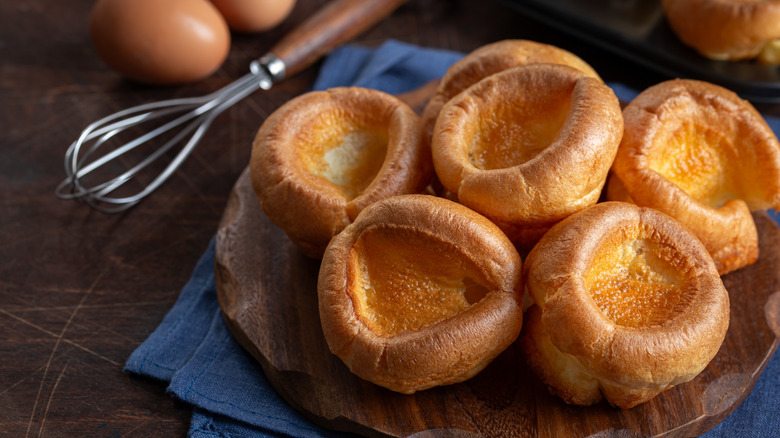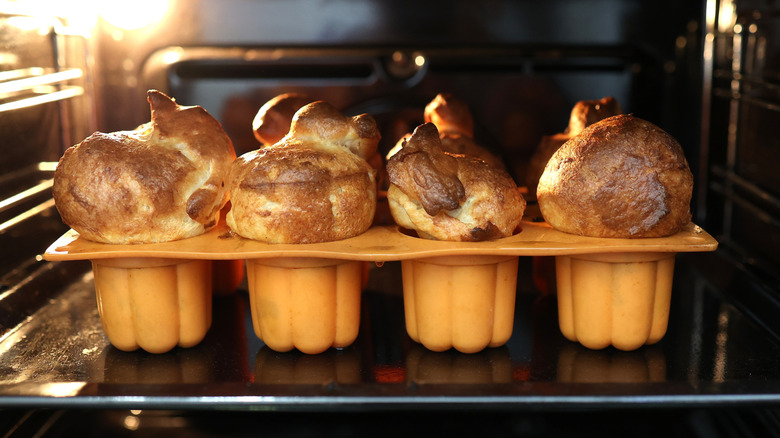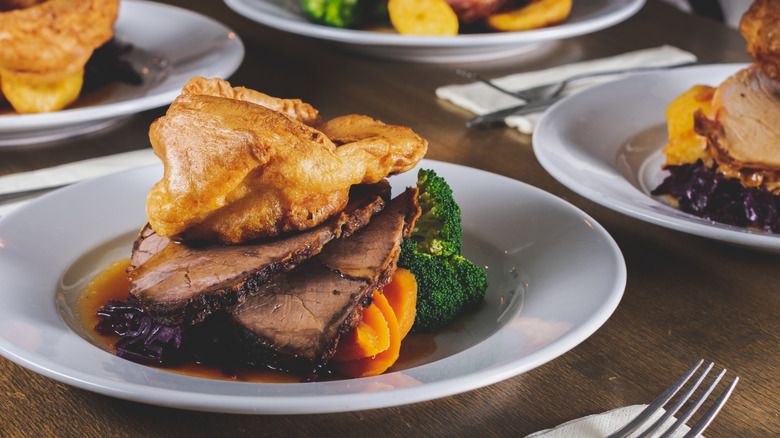How Does Yorkshire Pudding Differ From Popovers?
We may receive a commission on purchases made from links.
The Americans and British often enjoy a friendly spat over their respective cuisines. But those culinary traditions are, though neither country would readily admit it, more similar than many of us realize. Take, for example, a puffy, batter-based pastry, baked in hot fat and served as an iconic side dish. We talk, of course, of Yorkshire puddings. Or perhaps we mean popovers?
While on the face of things these two doughy dishes seem awfully similar, for those with a keen eye, they're actually quite different. So, what exactly is a Yorkshire pudding? Supposedly hailing from — you guessed it — Yorkshire, in the north of England, they're not sweet like you might expect. Instead, the word pudding originally referred to a savory, meat-centric dish. By the mid-18th century, however, people began to phase out the meat. Around the same time, in 1747, a cookbook called "The Art of Cookery Made Plain and Easy" made the first mention of the newly dubbed "Yorkshire pudding."
The recipe hasn't changed much to this day: a simple batter of flour, milk, and eggs, cooked in fat. Originally, that fat was beef dripping, as Yorkshire puddings were baked underneath a joint of roast beef, catching any excess fat. The popover, meanwhile, came around about a century later, likely a modification of the original Yorkshire recipe by English settlers in colonial America. Though similar, the traditional popover recipe calls for butter, not dripping, giving them a slight sweetness and a softer, slightly spongier texture.
Making Yorkshires puddings and popovers
When it comes to the preparation of Yorkshire puddings and popovers, there aren't too many differences. They both consist of a pancake-like batter of eggs, milk, all-purpose flour, and salt, beaten together to a smooth, pourable consistency — popovers add melted butter to the batter, though, giving them their moist, puffy texture. Neither uses a raising agent — instead, their characteristic fluffiness comes from intensely heating fat in the base of each of their purpose-made tins before adding the batter.
In the case of Yorkshire puddings, it's common nowadays for home cooks to use a neutral, high-smoke-point oil like vegetable or sunflower oil. For that classic Yorkshire pudding flavor, though, beef dripping is the way to go. It imparts a wonderful savoriness that pairs perfectly with a traditional Sunday roast. The puddings are then baked in a custom-made tray, which is essentially a shallow muffin pan. Yorkshires were originally (though rarely now) baked in one big pan, puffing up slightly above its rim, as opposed to the more dramatic rise of popovers.
Popovers, meanwhile, call for butter rather than dripping or oil, which gives them a rich, slightly sweet flavor rather than the more savory profile of Yorkshire puddings. They're also baked in a special type of pan, again reminiscent of a muffin tray, except rather than being shallow, like those used to make Yorkshire puddings, these are deeper and narrower, giving the popovers their shape as the batter "pops over" the top of the pan while rising.
How to serve Yorkshire puddings and popovers
Yorkshire puddings were originally meant to be served as an appetizer. In the days when meat was very expensive, they played an important role in filling up hungry working Brits before the main event of their Sunday roast. Today, though, they're a legendary side dish, and are most at home on a plate piled high with meat, potatoes, roasted vegetables, and lashings of gravy. Their savory flavor, brought by the dripping, makes them a perfect accompaniment to the big, beefy flavors of a roast. In the case of the legendary British classic, toad-in-the-hole, the batter is poured over sausages in a baking dish, encasing them in pastry and resulting in a crispy-in-bits, soft-in-others, meaty, fluffy traybake just begging to be doused in a traditional onion gravy.
Popovers, meanwhile, are a touch more versatile. The butter in their batter imparts a subtly sweet flavor, making them ideal both as a savory side or a standalone snack. Why not experiment by infusing the batter with different flavors? Havarti and dill popovers, for instance, offer a delightfully cheesy and herbaceous kick, though they are equally at home spread with a tart berry jam for a sweet treat. In fact, popovers can even make for a delicious and easy mid-week breakfast. Though they may have their differences, Yorkshires and popovers are united by one thing at least: they're both delicious!



